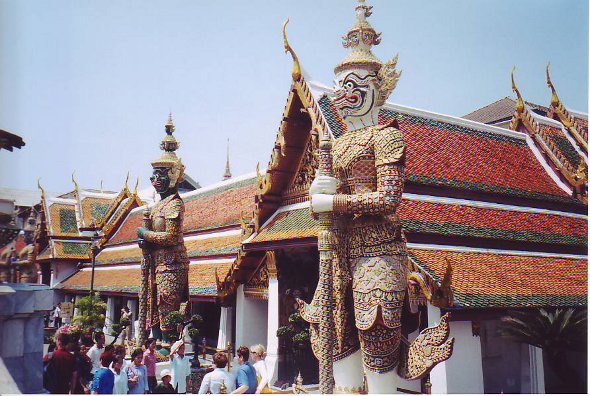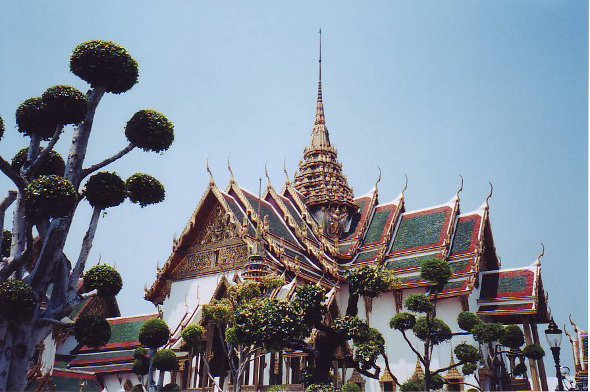Located in the same complex of buildings on the banks of the Chao Phraya River, Wat Phra Kaeo and the Grand Palace are regarded as ‘must-sees’ by many visitors to Bangkok.

The area of Ratanakosin was established as the Thai capital by King Rama 1 in 1782 following the fall of Ayutthaya to the Burmese. Modern day Bangkok has spread eastwards from the original site of Ratanakosin and Thonburi, but the original location remains easily accessible by boat and is within walking distance of the popular backpacking area of Banglamphu.
This temple is the holiest Buddhist site in the country and houses the revered Emerald Buddha image. Large guardian figures known as yaksha (pictured above) are located at every gate of the temple to protect the Emerald Buddha and keep away evil spirits.
Just as Wat Phra Kaeo is the holiest temple in the kingdom, the diminutive Emerald Buddha is the holiest image in Thailand. The origin of the Buddha image is in dispute with some experts believing it to have been made in Sri Lanka whilst others claim it was crafted in the 14th century in what is now Thailand. The Emerald Buddha is believed to bring good fortune to whoever possesses it and down the centuries it has been fought over by kings and empires. Legend has it that miracles were witnessed at the various places it has been interned including Chiang Mai, Chiang Rai and Lampang in northern Thailand. The Buddha image was seized by Laos invaders in 1552 and resided in Laos until 1779 before being recaptured by the Thai general who would go on to be crowned as King Rama 1.

The Emerald Buddha has remained in its present shrine in Wat Phra Kaeo since 1784 and both the Buddha image and the temple remain a focal point for important royal ceremonies. The 66cm figure sits on top of a 9-metre high pedestal and has three costumes, one for each season; hot, rainy and cool. The changing of the Emerald Buddha’s clothing at the beginning of each season is in itself a royal ceremony.
From the skytrain stop at Saphan Taksin, take a boat upriver to the pier at Tha Chang and you will see the complex on your right hand side before you alight at the pier. The entrance to Wat Phra Kaeo and the Grand Palace is located on Thanon Na Phra Lan.
Visitors must be respectfully dressed and will be refused admission if inappropriately attired. This means covering the shoulders, knees and wearing a shoe (or trainers/sneakers) with a heel. Shorts, flip-flops, sandals, singlets, spaghetti straps, fisherman’s pants are all inappropriate. Clothing can be hired (for a charge and a refundable deposit) both outside the complex and from a small booth just inside the complex near the turnstile entrance.
Entrance tickets to the grounds of the temple and the Grand Palace cost *200 500 Baht for foreigners. Opening times are from 08.30 – 15.30 daily except for days when ceremonies are taking place.
Update June 2013:
Price of entrance ticket is 500 Baht
Photographs are permitted throughout the grounds and inside the temple except for the main bot where the Emerald Buddha image is housed. Signs make it quite clear where you are not permitted to take photographs. Take care to point your feet away from all Buddha images. There is an article here about respectful ways to act in a Thai temple.
Don’t be too surprised if you are approached in the areas approaching the Grand Palace complex by a smartly dressed individual who may tell you they are a university student or a government official and that the temple and Grand Palace are closed. It’s quite an old scam which will then involve them trying to sweet-talk you into visiting gem shops or tailors’ shops. They can be very earnest and plausible, just smile politely and carry on walking to the entrance.
Photos © Thaizer